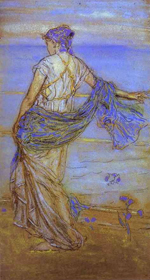
A Ridiculous Failure
"The day, according to any current valuation, had been a rather ridiculous failure" (172).
Points
for Reflection
The Age of Innocence (1920), chps 25-34 (172-254)
- how does Archer’s opinion of old New York’s “forms” and proprieties change across Book II?
- does Newland configure either May or Ellen as more a three-dimensional person than a symbol?
- does Newland’s marriage nurture more than it drains him?
- in the final analysis, is the marriage of May and Newland a failure? Be sure to include a discussion of the final chapter in your response.
- does duty ultimately provide Arthur a bedrock foundation on which to stand, or does it provide only a mirage of success—a pyrrhic victory?
- why might Wharton have earlier placed, outside Ellen’s residence in Newport, “a wooden Cupid who had lost his bow and arrow but continued to take ineffectual aim” (157 mid).
- what do you make of the fact that, each time Archer sees Ellen after a period of separation, he cannot remember such details as the sound of her voice (161), or the appearance of her face (199)?
- does Archer want a sexual relationship with Ellen Olenska?
- is Newland Archer unfaithful to his wife—does he betray his marital vows?
- early in Book II, M. Rivière tells Newland, “‘it’s worth everything . . . to keep one’s intellectual liberty, not to enslave one’s powers of appreciation, one’s critical independence’” Does Newland himself achieve this kind of intellectual independence as a married man?
- in what ways does the opera Faust, which opened the novel (3-4) and now helps close it (222), bookend the novel’s thematic concerns?
- does upper New York society operate from the assumption of females’ inner strength or weakness?
- why does Archer not ascend the stairs?

Annabel Lee (c.1890)
James Whistler
Dr. Paul Marchbanks
pmarchba@calpoly.edu
![]()
